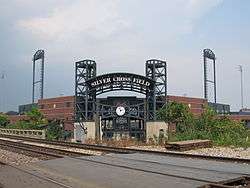Joliet, Illinois
| Joliet, Illinois | |
|---|---|
| City | |
| City of Joliet | |
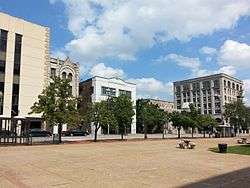 Downtown scene | |
| Etymology: Louis Jolliet | |
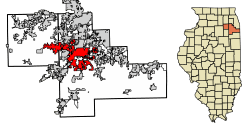 Location of Joliet in Will and Kendall counties in Illinois. | |
.svg.png) Location of Illinois in the United States | |
| Coordinates: 41°31′14″N 88°09′02″W / 41.52056°N 88.15056°WCoordinates: 41°31′14″N 88°09′02″W / 41.52056°N 88.15056°W | |
| Country | United States |
| State | Illinois |
| Counties | Will, Kendall |
| Townships | Joliet, Troy, Plainfield, Lockport, New Lenox, Jackson, Channahon, Seward, Na-Au-Say |
| Settled | 1833 |
| Incorporated | 1852 |
| Government | |
| • Type | Council-manager |
| • Mayor | Bob O'Dekirk (R) |
| Area[1] | |
| • Total | 65.09 sq mi (168.60 km2) |
| • Land | 64.43 sq mi (166.88 km2) |
| • Water | 0.66 sq mi (1.72 km2) |
| Elevation | 614 ft (187 m) |
| Population (2010)[2] | |
| • Total | 147,433 |
| • Estimate (2016)[3] | 149,395 |
| • Density | 2,301.10/sq mi (888.45/km2) |
| Time zone | UTC-6 (CST) |
| • Summer (DST) | UTC-5 (CDT) |
| Zip codes | 60431, 60432, 60433, 60434, 60435, 60436, 60586 |
| Area codes | 815, 779 |
| FIPS code | 17-38570 |
| Demonym | Jolietan |
| Wikimedia Commons | Joliet, Illinois |
| Website | www.cityofjoliet.info |
| [4][5] | |
Joliet (/ˈdʒoʊliɛt,
History
In 1673, Louis Jolliet, along with Father Jacques Marquette, paddled up the Des Plaines River and camped on a huge mound, a few miles south of present-day Joliet.[7] Maps from Jolliet's exploration of the area, placed a large hill or mound on what is now the southwest corner of the city, since there is no point that is farther southwest. That hill was named Mound Jolliet. The spot was mined by early settlers and is now a depression.
In 1833, following the Black Hawk War, Charles Reed built a cabin along the west side of the Des Plaines River. Across the river in 1834, James B. Campbell, treasurer of the canal commissioners, laid out the village of "Juliet", named after his daughter.[8] Just before the economic depression of 1837, Juliet incorporated as a village, but to cut tax expenses, Juliet residents soon petitioned the state to rescind that incorporation. In 1845, local residents changed the community's name from "Juliet" to "Joliet". Joliet was reincorporated as a city in 1852. Cornelius Covenhoven Van Horne was active in getting the city its first charter, and because of this he was elected Joliet's first Mayor. When the city later built a new bridge it was named The Van Horne Bridge.[9]
Geography
Joliet is located at 41°31′14″N 88°09′02″W / 41.52056°N 88.15056°W (41.5204200, -88.1505261).[4]
According to the 2010 census, Joliet has a total area of 62.768 square miles (162.57 km2), of which 62.11 square miles (160.86 km2) (or 98.95%) is land and 0.658 square miles (1.70 km2) (or 1.05%) is water.[10] It has a sprawling, irregular shape that extends into nine different townships, more than any other Illinois city. They are: Joliet, Plainfield, Troy, New Lenox, Jackson, Channahon, and Lockport in Will County, and Na-Au-Say and Seward in Kendall County. Joliet is a Des Plaines River town, with the downtown located in the river valley. This is especially evident on Interstate 80 if one is coming from the east or the west where it has been flat for many miles and suddenly the land drops as one approaches the river. This offers a great view looking north to see downtown Joliet. For most of its existence Joliet geographically has had its "west side" and "east side", referring to areas to the west or the east of the Des Plaines River, which runs through the city. Both sides were roughly proportionate throughout most of its history until the 2nd half of the 20th century when westward expansion began.
Many businesses moved from the downtown area to the expanding areas west of the river. Many stores relocated to the west side in new strip malls and shopping centers with more parking and easier access. This began the decline of the downtown shopping district which is still felt today. Today Joliet has a "west side" and a "far west side" (which includes all city limits in Kendall County). This has given rise to a newly referenced "Central Joliet" portion of the city which essentially is all land west of the Des Plaines River and east of Interstate 55. This new reference may soon change the current meaning of "west side" to west of Interstate 55.
Waterways
While the heart and history of Joliet is centered around the Des Plaines River Joliet actually expands across both the Des Plaines River and the DuPage River. There are several other waterways that traverse through the city limits including Hickory Creek, Spring Creek, the historic Illinois and Michigan Canal, Jackson Creek, and Aux Sable Creek. Some small lakes and bodies of water include Chase Lake, Lake Juco, Michigan Beach, the Brandon Road Quarry, and Leisure Lake.
Climate
Joliet has a hot summer humid continental climate(Köppen Dfa) with hot, wet summers, and cold winters with moderate to heavy snowfall.
| Climate data for Joliet, Illinois (Brandon Dam), 1981–2010 | |||||||||||||
|---|---|---|---|---|---|---|---|---|---|---|---|---|---|
| Month | Jan | Feb | Mar | Apr | May | Jun | Jul | Aug | Sep | Oct | Nov | Dec | Year |
| Average high °F (°C) | 31 (−1) |
36 (2) |
47 (8) |
61 (16) |
71 (22) |
81 (27) |
84 (29) |
83 (28) |
76 (24) |
64 (18) |
50 (10) |
35 (2) |
60 (15) |
| Average low °F (°C) | 16 (−9) |
20 (−7) |
29 (−2) |
39 (4) |
49 (9) |
59 (15) |
64 (18) |
63 (17) |
54 (12) |
43 (6) |
33 (1) |
20 (−7) |
41 (5) |
| Average precipitation inches (mm) | 1.80 (45.7) |
1.73 (43.9) |
2.25 (57.2) |
3.49 (88.6) |
3.97 (100.8) |
3.82 (97) |
4.33 (110) |
3.85 (97.8) |
3.01 (76.5) |
2.86 (72.6) |
3.03 (77) |
2.16 (54.9) |
36.29 (921.8) |
| Average precipitation days (≥ 0.01 in) | 10.6 | 8.9 | 10.6 | 11.4 | 11.3 | 10.2 | 9.4 | 9.0 | 8.2 | 9.5 | 10.8 | 11.2 | 121.2 |
| Source: NOAA[11] | |||||||||||||
Demographics
| Historical population | |||
|---|---|---|---|
| Census | Pop. | %± | |
| 1840 | 2,558 | — | |
| 1850 | 2,659 | 3.9% | |
| 1860 | 7,104 | 167.2% | |
| 1870 | 7,263 | 2.2% | |
| 1880 | 11,657 | 60.5% | |
| 1890 | 23,264 | 99.6% | |
| 1900 | 29,353 | 26.2% | |
| 1910 | 34,670 | 18.1% | |
| 1920 | 38,442 | 10.9% | |
| 1930 | 42,993 | 11.8% | |
| 1940 | 42,365 | −1.5% | |
| 1950 | 51,601 | 21.8% | |
| 1960 | 66,780 | 29.4% | |
| 1970 | 78,827 | 18.0% | |
| 1980 | 77,956 | −1.1% | |
| 1990 | 76,836 | −1.4% | |
| 2000 | 106,221 | 38.2% | |
| 2010 | 147,459 | 38.8% | |
| Est. 2016 | 149,395 | [3] | 1.3% |
| [12][13] | |||
As of July 2014, Joliet was the 169th most populous city in the United States.[14]
As of the census of 2010, there were 147,433 people, 48,019 households, and 34,900 families residing in the city. The population density was 2,288.3 people per square mile (883.5/km²). There were 51,285 housing units at an average density of 796 per square mile (307.3/km²). The racial makeup of the city was 67.48% White, 15.98% African American, 0.32% Native American, 1.93% Asian, 0.02% Pacific Islander, 11.32% from other races, and 2.95% from two or more races. Hispanic or Latino of any race were 27.84% of the population.
There were 48,019 households out of which 30.6% had children under the age of 18 living with them, 53.1% were married couples living together, 14% had a female householder with no husband present, and 27.3% were non-families. 22.1% of all households were made up of individuals and 7.5% had someone living alone who was 65 years of age or older. The average household size was 3.01 and the average family size was 3.56.[2]
In the city, the population was spread out with 30.8% under the age of 18, 9.1% from 18 to 24, 31.6% from 25 to 44, 20.1% from 45 to 64, and 8.4% who were 65 years of age or older. The median age was 31.7 years. For every 100 females, there were 97.8 males. For every 100 females age 18 and over, there were 94.8 males.[15]
For 2015, the median income for a household in the city was $60,976, and the median income for a family was $69,386. Full-time, year-round working males had a median income of $51,082 versus $39,235 for females. The per capita income for the city was $24,374. About 10.4% of families and 12.2% of the population were below the poverty line, including 16.2% of those under age 18 and 8.4% of those age 65 or over.[16]
From April 1, 2010 to July 1, 2011, Joliet was the fastest-growing city in the Midwestern United States and the 18th fastest-growing city in the United States among incorporated places with more than 100,000 people.[14]
Economy
Like many Midwestern and East Coast cities dependent on manufacturing industries, Joliet has experienced past economic troubles. Current rates of unemployment in Joliet are around 8.6%.[17] The city is evolving from a steel and manufacturing suburb to a commuter suburb in the Chicago metropolitan area. Some new migrants to the Chicago area are working in bordering Cook County (the nation's second-most populous county) and living in Joliet.
The downtown area of Joliet has slowly attracted new businesses to the area. The main attractions in Joliet's city center are the Harrah's Casino, Joliet Slammers baseball (Joliet Route 66 Stadium), Hollywood Casino, and the Rialto Square Theatre, also known as the 'Jewel of Joliet', and has been called one of the world's 10 most beautiful theaters. The 1999 film Stir of Echoes starring Kevin Bacon had scenes shot on at the Rialto Square Theatre (the hypnotism scenes in which James saw the word "Dig" on the movie screen), at the corner of Scott Street and Washington, and at the old Menards that took over the Wieboldt's building at Jefferson Square Mall. The lobby of the Rialto Square Theatre also served the filming of John Goodman's "Balto".
Largest employers
According to the City's 2009 Comprehensive Annual Financial Report,[18] the largest employers in the city were:
| # | Employer | # of Employees |
|---|---|---|
| 1 | Presence Saint Joseph Medical Center | 2,500 |
| 2 | County of Will | 2,400 |
| 3 | Silver Cross Hospital (now located in New Lenox) | 1,800 |
| 4 | Hollywood Casino Joliet | 1,756 |
| 5 | Ikea | 1,500 |
| 6 | Joliet Public School District 86 | 1,430 |
| 7 | Harrah's Joliet | 1,100 |
| 8 | University of St. Francis | 1,100 |
| 9 | Filtration Group | 900 |
| 10 | Joliet Township High School District 204 | 900 |
Landmarks
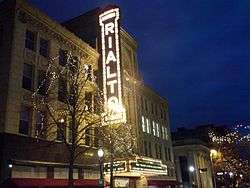
Among local landmarks are the Joliet Area Historical Museum and Route 66 Visitors Center as well as the Chicagoland Speedway (NASCAR) and the Route 66 Raceway (NHRA).
The Joliet Prison is located near Joliet's downtown district on Collins Street. The prison has been featured in both television shows and movies. One such television series filmed at Joliet Prison was Prison Break.[19] The Prison was also used for the opening scenes in the 1980 movie, The Blues Brothers, which starred John Belushi as "Joliet" Jake Blues and Dan Aykroyd as Elwood Blues.[20]
The first Dairy Queen store opened in Joliet.[21] The location is now occupied by Universal Church.
The Rialto Square Theatre, a favorite haunt of Al Capone and filming location for scenes from Kevin Bacon's film Stir of Echoes, is on Chicago Street, downtown.[22]
Near the theatre, the Joliet Area Historical Museum commemorates the history of Joliet, especially its heritage as a stopping point on U.S. Route 66.[23]
There are two casinos which originated as riverboat casino in Joliet: the Hollywood Casino near Channahon and a Harrah's hotel and casino downtown. Joliet is the only city in the State of Illinois to have two casinos.[24]
The Louis Joliet Mall is located near the intersection of I-55 and U.S. Route 30.[25]
The Auditorium Building is located at the northeast corner of Chicago and Clinton streets. Designed by G. Julian Barnes and built of limestone in 1891, it was controversial as one of the first buildings to combine religious, civic and commercial uses. Nonetheless, people such Theodore Roosevelt visited and spoke at the building.[26] The building was originally built for the Universalist Unitarian Church of Joliet; however, the church sold the building in 1993, and it is no longer home to the congregation.[27]
The Jacob A. Henry Mansion, 20 South Eastern Avenue is a three-story, red brick, Second Empire/Italian Renaissance style structure built on a Joliet limestone foundation in 1873 (completed in 1876). The structure is set on bedrock and the entire basement floor is made of Joliet limestone from the building owner's quarry. The walls of the structure are constructed of red Illinois sandstone and deep red brick specially fired in Ohio (wrapped individually and shipped by barge to Joliet). A commanding three-story tower is the focal point of the structure. The structure has steel trim with slate shingles on a Mansard roof. The front and side porches are single slabs of limestone. The largest stone ever quarried lies in the sidewalk under the front entry gate. The stone is 9'×22'×20" thick. In 1885, an immense Byzantine dome was added to the south façade.
The interior of the Jacob A. Henry Mansion has elaborate polished walnut woodwork, massive, carved pocket doors, original wood mantles and a solid walnut staircase. The original owner, Mr. Henry, was a railroad magnate, building railroads in Indiana, Ohio and Illinois. He had ownership in a local quarry and was a principal stockholder in Will County National Bank. The mansion won the Architecture Award at the American Centennial Celebration in Philadelphia in 1876. The structure is a local landmark, part of the East Side National Register District and individually listed on the National Register of Historic Places.
The former Joliet Arsenal (now the site of both the Abraham Lincoln National Cemetery and the Midewin National Tallgrass Prairie) is in nearby Elwood.
Sports
Numerous state and national titles have been won by the Joliet Township High School and grade school bands as well as by the Joliet American Legion Band[28] over several decades.
Joliet is home to three high schools that bear its name: Joliet Central, Joliet West, and Joliet Catholic Academy (JCA), in addition to the closed Joliet East,[29] each of which has sports programs. JCA has been a major football powerhouse for many years and has won more state football titles than any other team in the state, with 13 as of 2009.[30]
Joliet also is home to a minor league baseball team, the Joliet Slammers of the independent Frontier League. Since the beginning of the 2011 season, they have played their home games at Joliet Route 66 Stadium. The Slammers replace the former Joliet JackHammers of the Northern League. The Joliet Slammers won the 2011 Frontier League Championship in their first season as a team.[31]
Chicagoland Speedway hosts annual events from NASCAR. During major races, the large influx of fans means that the number of people in the city is double that of the official figure. Next door to the Speedway, the Route 66 Raceway features National Hot Rod Association events on its drag-strip. Joliet Central has become actively involved in Route 66 by building an alternative fuel vehicle.[32] Autobahn Country Club, also located in Joliet, has held the SCCA World Challenge, Atlantic Championship and Star Mazda Championship races since 2009.
Parks and recreation
Golf courses
There are four golf courses located in the city of Joliet, they are:
- Inwood Golf Course
- Woodruff Golf Course
- Wedgewood Golf Course
- Joliet Country Club
Family entertainment
Joliet has 2 miniature golf courses at Haunted Trails located off of Broadway Street.
Joliet has a water park on Route 6 called Splash Station.
The Pilcher Park Nature Center, located in Pilcher Park, hosts many youth and educational programs.
Pilcher Park, one of Joliet's oldest parks, is home to over 640 acres (260 ha) of land that provide a habitat for abundant wildlife and outdoor recreation. Pilcher Park also contains Native American Indian remains and was the site of a Potowatami Indian village. There is a burial mound just south of the entrance on Gougar Road. On the south side of the bridge next to gougers farm house. And a marked burial plot inside the park grounds.
Hammel Woods is also located in Joliet with miles of hiking trails and even a seven-acre dog park.
Splash Station Waterpark featuring the Midwest's only 6 person slide is also located on Route 6 in Joliet.
Louis Joliet Mall located on Route 30 in Joliet hosts a large Cinemark theatre
Bicycle trails
There are several miles of bike trails, which wind through Joliet. The Rock Run and Joliet Junction Trails are roughly North/South routes that begin at the Theodore Marsh in Crest Hill, Illinois and have southern terminuses on the I&M Canal State Trail. These three paths can be used as a 16-mile loop through western Joliet. The I and M Canal State Trail stretches about 60 miles to Peru, Illinois for longer bike rides.
Education
As of 2009 almost all public school students in Joliet attend schools in Joliet Public Schools District 86 and Joliet Township High School District 204.[33] and Plainfield Consolidated School District 202.
Colleges and universities
- Joliet Junior College, the nation's first public community college
- University of St. Francis
High schools
School districts serving Joliet include Joliet Township High School District 204, Plainfield Community Consolidated School District 202, Oswego Community Unit School District 308, Minooka Community High School District 111.
| High School | Established | Enrollment | Funding | Location | Mascot |
|---|---|---|---|---|---|
| Joliet Catholic Academy | 1869 | 1200 | Private | 1200 North Larkin Avenue, Joliet, Illinois, 60435 |
Hilltoppers (m), Angels (f) |
| Joliet Central High School | 1901 | 3,005 | Public | 201 East Jefferson Street, Joliet, Illinois, 60432 |
Steelmen (m), Steelwomen (f) |
| Joliet West High School | 1964 | 3,125 | Public | 401 North Larkin Avenue, Joliet, Illinois, 60435 |
Tigers |
Elementary and middle schools
Elementary and middle school districts serving Joliet include:
- Joliet Public Schools District 86
- Troy Community Consolidated School District 30-C (Also serves neighboring communities of Plainfield, Illinois and Shorewood, Illinois)[34]
Career training
Since the early 1980s, the Job Corps of the U.S. Department of Labor has operated the Joliet Job Corps Center on the campus of the former Joliet East High School.[35]
Notable people
Infrastructure
City limits
Joliet current city limits reach as far as follows:
- To the north: Theodore Street (older main section of the city)/Renwick Road (in the NW Crystal Lawns subdivision)
- To the south: Noel Road
- To the east: Wirt Road
- To the west: Grove Road (Kendall County)
State government
The Illinois Youth Center Joliet (IYC Joliet), a juvenile correctional facility of the Illinois Department of Juvenile Justice, opened in April 1959.[36]
Stateville Correctional Center, one of five maximum security prison for the state of Illinois,[37] is located in the neighboring city of Crest Hill.[38][39] It is a part of the Illinois Department of Corrections.
Transportation
.jpg)
Situated approximately 40 miles (64 km) southwest of central Chicago, Joliet has long been a significant transportation hub. It lies on both sides of the Des Plaines River, a major waterway in Northern Illinois, and was one of the principal ports on the Illinois and Michigan Canal. The Chicago & Rock Island Railroad and Michigan Central came through in the 1850s, and the Atchison, Topeka and Santa Fe Railway and Chicago & Alton Railroad soon followed, with the Elgin, Joliet and Eastern Railway and Milwaukee Road lines built around the turn of the century. U.S. Highways 6 (the Grand Army of the Republic Highway), 30 (the Lincoln Highway), 45, 52, and 66 (Route 66) all ran through the city. In the 1960s, Interstate 55 and Interstate 80 made their way through Joliet, linking up near Channahon just west of the city limits. The phrase "Crossroads of Mid-America", found on the Joliet seal, is an allusion to the intersection of I-80 and I-55.
Joliet Transportation Center is the final stop on the Metra rail lines from Chicago for the Heritage Corridor route from Chicago Union Station and the Rock Island District route from LaSalle Street Station. A third line would also terminate at the station, The STAR Line, from O'Hare Transfer with an additional stop at Division St. PACE provides local bus service six days a week (no service on Sundays) with buses leaving from a terminal in downtown Joliet once an hour. Amtrak, the national passenger rail system, also serves Joliet, operating its Texas Eagle daily in each direction between Chicago and San Antonio, Texas.
Airports
The Joliet Regional Airport is located off of Jefferson Street near Interstate 55. Lewis University Airport is located to the north in the nearby village of Romeoville and is owned by the Joliet Regional Port District.
Major highways
Major highways in Joliet include:
|
Interstate Highways |
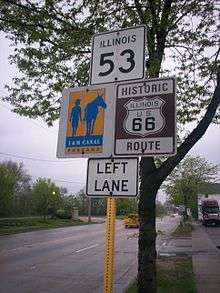
Hospitals
Joliet currently has one hospital within its city limits: Provena Saint Joseph Medical Center (also known as St. Joe's), located on the west side. Silver Cross Hospital, now located in neighboring New Lenox, was located on Joliet's east side. These were the only two hospitals in the history of the existence of Will County until Adventist Bolingbrook Hospital opened in January 2008. In September 2008, Silver Cross Hospital broke ground for a new facility on Maple Road (U.S. Route 6) in New Lenox, immediately west of Interstate 355. All patients were transferred to the new hospital on February 26, 2012, and the old facility was completely vacated.[40]
Religion
Joliet is home to the Roman Catholic Diocese of Joliet, with Bishop R. Daniel Conlon, and Auxiliary Bishop Joseph M. Siegel. Bishop J. Peter Sartain, former bishop of Joliet, was appointed by Pope Benedict XVI as Archbishop of Seattle. Joliet holds a very large Catholic population, and many Catholic institutions, including Joliet Catholic Academy.
According to the official website for the city of Joliet:
Joliet's diverse faith community represents over 60 denominations and offers residents services at more than 150 churches, synagogues, and houses of worship. Along with their spiritual offerings, these houses of worship enrich the Joliet area by providing some of the area's finest examples of Romanesque, Gothic, Byzantine, and Renaissance architecture. The spiritual community in Joliet welcomes newcomers with open arms, offering regular worship services and religious education.[41]
Popular culture
In the 1973 Academy Award-winning film, The Sting, the protagonist Johnny Hooker is from Joliet, and the film's story begins there.
In The Blues Brothers, John Belushi's Jake Blues is nicknamed "Joliet Jake" as he was imprisoned at the now closed Joliet Correctional Center.
The Joliet Prison has been a site for many other films and television shows, such as the film Let's Go to Prison, and the opening season of Fox's Prison Break was filmed predominately at the Joliet Prison, at which time part of the prison was still in use.
Joliet is portrayed in the television series Supernatural in the Season 2 episode "What Is and What Should Never Be" when the main characters stay at the fictional Joliet Motel.
Daniel Eugene "Rudy" Ruettiger grew up in Joliet and attended Joliet Catholic Academy. His story was told in the 1993 film Rudy.
See also
- List of cities in Illinois
- List of Midwestern cities by size
- List of towns and cities with 100,000 or more inhabitants/cityname: J
- List of towns and cities with 100,000 or more inhabitants/country: T-U-V-W
- List of United States cities by population
- List of U.S. states' largest cities by population
- Sehring Castle
References
- ↑ "2016 U.S. Gazetteer Files". United States Census Bureau. Retrieved June 30, 2017.
- 1 2 3 "Profile of General Population and Housing Characteristics: 2010". American Factfinder. U.S. Census Bureau. Retrieved October 8, 2017.
- 1 2 3 "Joliet growing; now third-largest claim awaits further review". The Herald-News. Retrieved October 8, 2017.
- 1 2 U.S. Geological Survey Geographic Names Information System: City of Joliet
- ↑ "Draft Consolidated Plan 2010" (PDF). City of Joliet. November 5, 2009. pp. 9, 35. Archived from the original (PDF) on October 6, 2010. Retrieved March 2, 2010.
- ↑ "Find a County". National Association of Counties. Archived from the original on May 31, 2011. Retrieved June 7, 2011.
- 1 2 Grossman, James R.; Keating, Ann Durkin; Reiff, Janice L. (2005) [2004]. Electronic Encyclopedia of Chicago (Online ed.). Chicago: Chicago Historical Society, Newberry Library. p. 676. ISBN 0-226-31015-9. OCLC 60342627.
- ↑ Gannett, Henry (1905). THE ORIGIN OF CERTAIN PLACE NAMES IN THE UNITED STATES (PDF). Washington: WASHINGTON GOVERNMENT PRINTING OFFICE. p. 170.
- ↑ "Robert-C-Boyett - User Trees - Genealogy.com". www.genealogy.com. Retrieved May 2, 2018.
- ↑ "G001 - Geographic Identifiers - 2010 Census Summary File 1". United States Census Bureau. Retrieved December 27, 2015.
- ↑ "NowData – NOAA Online Weather Data". National Oceanic and Atmospheric Administration. Retrieved February 11, 2013.
- ↑ "Census of Population and Housing". U.S. Census Bureau. Archived from the original on May 12, 2015. Retrieved September 15, 2014.
- ↑ "2013 Population Estimates". Annual Estimates of the Resident Population: April 1, 2010 to July 1, 2013. U.S. Census Bureau. Retrieved September 15, 2014.
- 1 2 "Annual Estimates of the Resident Population for Incorporated Places of 50,000 or More, Ranked by July 1, 2013 Population: April 1, 2010 to July 1, 2013". U.S. Census Bureau, Population Division. May 2014. Retrieved September 15, 2014.
- ↑ "Age Groups and Sex: 2010". U.S. Census Bureau. Retrieved October 8, 2017.
- ↑ "SELECTED ECONOMIC CHARACTERISTICS". U.S. Census Bureau. Retrieved October 8, 2017.
- ↑ "Unemployment Rate in Chicago-Naperville-Joliet". FRED Economic Data. Federal Reserve Bank of St.Louis. Retrieved March 16, 2013.
- ↑ City of Joliet CAFR Archived December 11, 2010, at the Wayback Machine.
- ↑ Joliet is one of the characters on 'Prison Break' - today > entertainment - today > entertainment > tv - TODAY.com. Today.msnbc.msn.com (November 9, 2005). Retrieved on August 17, 2013.
- ↑ 'Blues Brothers' movie showing Friday at Joliet's old Stateville Prison | abc7chicago.com. Abclocal.go.com (August 13, 2010). Retrieved on August 17, 2013.
- ↑ Dairy Queen. dairyqueen.com. Retrieved on August 17, 2013.
- ↑ Filming Locations of Chicago and Los Angeles: Stir Of Echoes. Itsfilmedthere.com. Retrieved on August 17, 2013.
- ↑ "Joliet Area Historical Museum". Joliet Area Historical Museum. Retrieved April 30, 2014.
- ↑ Illinois Casino Map. Worldcasinodirectory.com. Retrieved on August 17, 2013.
- ↑ Louis Joliet Mall Archived April 23, 2012, at the Wayback Machine.. Westfield.com. Retrieved on August 17, 2013.
- ↑ "Site Unavailable". www.uucj.com. Retrieved May 2, 2018.
- ↑ UUCJ 175th Anniversary. Uucj.com. Retrieved on August 17, 2013.
- ↑ Joliet American Legion Band - Home. Jolietlegionband.org (July 21, 2012). Retrieved on August 17, 2013.
- ↑ http://www.jths.org/about204/district-history/
- ↑ Records & History. Ihsa.org. Retrieved on August 17, 2013.
- ↑ Frontier League Professional Baseball. Frontierleague.com. Retrieved on August 17, 2013.
- ↑ "Cuisine Jardin Inspiration - midwestalternativefuelvehicleexpo.com". Cuisine Jardin Inspiration. Retrieved May 2, 2018.
- ↑ "Changes make the grade for Joliet schools" (Archive). Chicago Tribune. February 18, 2009. Retrieved on August 3, 2015.
- ↑ "Troy CCSD 30-C". maps.troy30c.org. Retrieved May 2, 2018.
- ↑ "Archived copy". Archived from the original on March 6, 2014. Retrieved March 6, 2014.
- ↑ "Illinois Youth Center Joliet." Illinois Department of Juvenile Justice. Retrieved on October 27, 2012.
- ↑ "Archived copy" (PDF). Archived from the original (PDF) on August 20, 2014. Retrieved March 6, 2014.
- ↑ 2010 CENSUS – CENSUS BLOCK MAP: Crest Hill city, IL." (Archive) U.S. Census Bureau. Retrieved on October 27, 2012.
- ↑ "Stateville Correctional Center Archived August 28, 2012, at the Wayback Machine.." Illinois Department of Corrections. Retrieved on October 27, 2012. "Business Mail: 16830 So. Broadway St. P.O. Box 112 Joliet, IL 60434 "
- ↑ Lundquist, Janet (March 28, 2012). "Silver Cross Hospital moves from Joliet to New Lenox". Post-Tribune. Retrieved September 15, 2014.
- ↑ "City of Joliet: For Residents-Worship". Archived from the original on September 11, 2008.
External links
| Wikimedia Commons has media related to Joliet, Illinois. |
